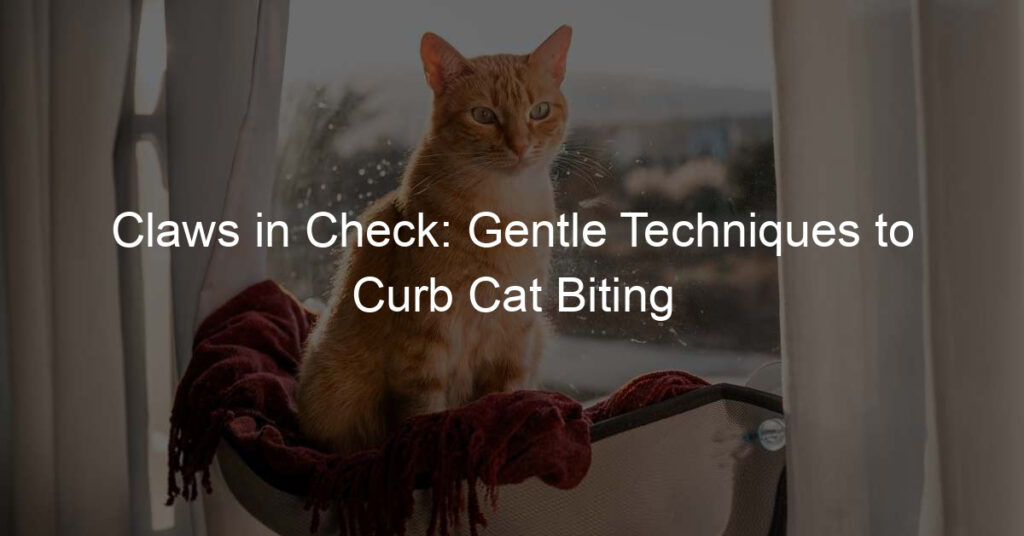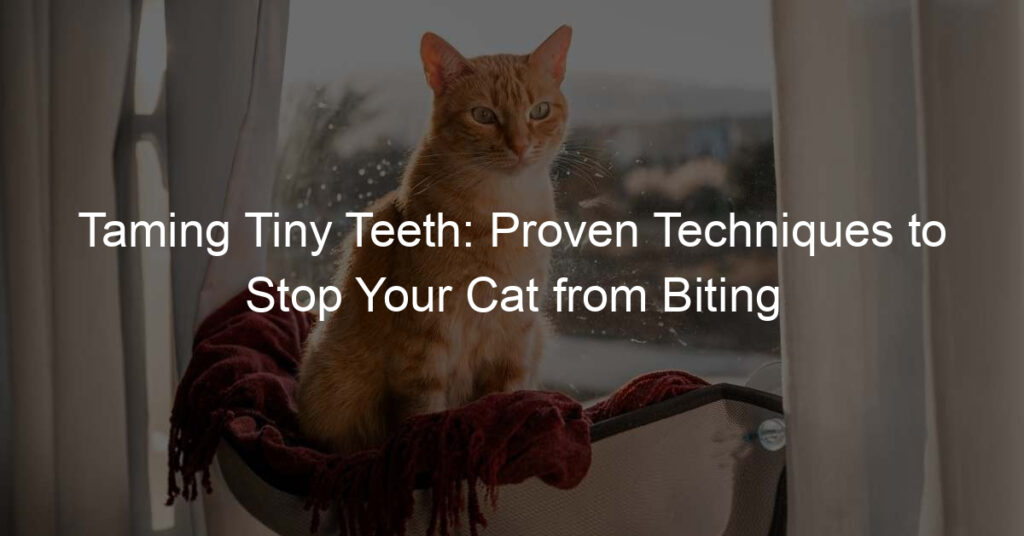
Introduction to Cat Biting
When it comes to our feline friends, biting can be a common behavior. But what does it mean, and how does it impact both the cat and its owner? In this section, we will delve into understanding cat biting, the common reasons behind it, and its impact.
- Understanding Cat Biting Behavior
- Common Reasons for Cat Biting
- Playfulness: Cats, especially kittens, often bite during play as a way to practice their hunting skills.
- Fear or Aggression: If a cat feels threatened or scared, it might bite as a form of self-defense.
- Overstimulation: Cats can become overstimulated during petting or play, leading to a bite.
- Health Issues: Pain or discomfort due to health issues can also cause a cat to bite.
- The Impact of Cat Biting on Owners and Cats
Cat biting is a form of communication. Cats use biting to express a variety of emotions and needs. This can range from fear and aggression to affection and playfulness. It’s important to note that biting doesn’t always signify a problem. It can simply be a part of your cat’s normal behavior. However, excessive or aggressive biting may indicate underlying issues.
There are several reasons why a cat might bite. These include:
While some cat bites are harmless, others can have serious consequences. For owners, cat bites can cause pain and potentially lead to infections. For cats, frequent or aggressive biting can be a sign of stress, fear, or health problems. It’s important for owners to understand and address the cause of biting to ensure the wellbeing of their pets.
In the following sections, we will explore how to prevent cat biting, teach your cat gently, and modify their behavior for a bite-free future.
Cat Biting Prevention
Preventing cat biting begins with understanding the signs of aggression and distinguishing between playful and harmful biting. Let’s delve into these aspects.
Recognizing the Signs
It’s crucial to recognize the signs of aggressive behavior in your cat. This will help you intervene before a bite occurs. Here are two key factors to consider:
- Identifying aggressive cat behavior: Cats often display certain behaviors when they are feeling aggressive. These can include hissing, growling, swatting, or a rigid, tense body posture. Their ears might flatten against their head, and their tail may puff up. If you notice these signs, it’s best to give your cat some space to calm down.
- Understanding the difference between playful and harmful biting: Not all biting is a sign of aggression. Cats often bite during play as a way to practice their hunting skills. Playful biting is usually gentle and doesn’t break the skin. On the other hand, aggressive biting is often harder and may be accompanied by other signs of aggression like hissing or growling. If your cat’s bites are causing pain or injury, it’s important to address this behavior.
Recognizing these signs is the first step towards preventing cat biting. In the next section, we will discuss various techniques to stop cat biting and non-aggressive cat training methods.
Preventing Aggressive Cat Behavior
It’s essential to understand that preventing aggressive behavior in cats starts with a combination of proper training techniques and understanding your furry friend’s needs. Let’s delve into some effective strategies to prevent cat biting and promote a harmonious relationship with your pet.
- Techniques to Stop Cat Biting
- Non-Aggressive Cat Training Methods
One of the most effective ways to stop cat biting is through redirection. If your cat starts to bite, redirect its attention to a toy. This method teaches the cat that biting is not acceptable, but playing with toys is. It’s also crucial to reward good behavior. When your cat interacts with you without biting, give it a treat or some extra cuddle time. This positive reinforcement encourages your cat to continue the good behavior.
Non-aggressive cat training methods focus on building a positive relationship between you and your cat. One such method is clicker training, which uses a sound to signal to your cat that it has done something right and will receive a reward. This method is effective because it allows you to communicate with your cat in a way it understands.
Another non-aggressive training method is the use of pheromone diffusers. These devices release a scent that mimics the natural pheromones produced by mother cats to calm their kittens. Using a pheromone diffuser in your home can help create a more relaxed environment for your cat, reducing its aggressive behavior.
In conclusion, preventing aggressive cat behavior involves understanding your cat’s needs, using effective training techniques, and rewarding good behavior. With patience and consistency, you can help your cat become a more relaxed and friendly companion.
| Technique | Description |
|---|---|
| Redirection | Redirecting your cat’s attention to a toy when it starts to bite. |
| Positive Reinforcement | Rewarding your cat when it interacts with you without biting. |
| Clicker Training | Using a sound to signal to your cat that it has done something right and will receive a reward. |
| Pheromone Diffusers | Using a device that releases a calming scent, mimicking the natural pheromones produced by mother cats. |
Gentle Teaching for Cats
Training cats can be a challenging task, but with gentle teaching methods, it can be made easier. One of the most common issues cat owners face is biting. Here, we will discuss some effective ways to train your cat not to bite.
Training Cats Not to Bite
There are several steps you can take to train your cat not to bite. These steps are simple, but they require consistency and patience. Let’s explore these steps in detail:
- Establishing boundaries
- Using positive reinforcement
- Consistent training practices
Just like children, cats also need to understand their boundaries. When your cat bites, it’s important to react immediately. A firm “No!” can help them understand that biting is not acceptable. Remember, it’s essential to be consistent so your cat can understand what’s expected of them.
Positive reinforcement is a powerful tool in training cats. When your cat behaves appropriately, reward them with a treat or their favorite toy. This will encourage them to repeat the good behavior. According to a study, cats respond better to positive reinforcement than to punishment.
Consistency is key in training cats. If you react to biting one day and ignore it the next, your cat will get confused. Make sure to react the same way every time your cat bites. Over time, your cat will understand that biting leads to negative consequences and will stop the behavior.
In conclusion, training a cat not to bite involves establishing clear boundaries, using positive reinforcement, and maintaining consistent training practices. With patience and consistency, your cat can learn to stop biting and become a more pleasant companion.
Understanding and Responding to Cat Biting
When it comes to our feline friends, biting can sometimes be a form of communication. It’s important to understand what your cat is trying to tell you and respond in a way that promotes positive behavior. Let’s delve into interpreting cat biting signals and how to respond with gentle training methods.
- Interpreting Cat Biting Signals
- Responding to Biting with Gentle Cat Training Methods
- Redirect the Bite: If your cat is in a playful mood and starts to bite, redirect their attention to a toy. This teaches them that toys, not humans, are for biting.
- Use Positive Reinforcement: Reward your cat when they play without biting. This could be with a treat, petting, or verbal praise. This reinforces the idea that not biting leads to good things.
- Be Consistent: It’s important to respond the same way every time your cat bites. This consistency helps your cat understand and learn from the consequences of their actions.
Cats use biting as a form of communication. It can mean a variety of things, from playfulness to discomfort or fear. The key is to pay attention to the context and other signals your cat is giving you.
| Signal | Meaning |
|---|---|
| Light, playful bites | Your cat is in a playful mood and wants to engage with you. |
| Hard, aggressive bites | Your cat may be scared, uncomfortable, or protecting its territory. |
| Biting followed by licking | This is often a sign of affection from your cat. |
Once you’ve interpreted your cat’s biting signals, it’s time to respond. Remember, the goal is not to punish your cat, but to teach them that biting is not an acceptable form of communication.
Remember, patience is key when training your cat. It may take time, but with consistent and gentle training methods, you can help your cat understand that biting is not acceptable.
Cat Behavior Modification
Understanding and modifying your cat’s behavior can be a challenging task, but it’s essential for a harmonious coexistence. One such behavior that needs addressing is cat biting. While some biting is normal, especially during play, excessive or aggressive biting can be a problem.
Professional Help for Cat Biting
There are times when professional help may be necessary to curb your cat’s biting behavior. Let’s explore when to seek professional help and how they can assist.
- When to seek professional help
- How professionals can help with cat biting solutions
If your cat’s biting behavior is causing harm or distress, it may be time to seek professional help. This is especially true if the biting is aggressive, frequent, or seems to be getting worse over time. A sudden change in behavior can also be a sign of underlying health issues, so it’s always best to consult with a professional if you’re unsure.
Professional animal behaviorists or veterinarians have the knowledge and experience to help manage your cat’s biting behavior. They can assess your cat’s health and behavior, identify any triggers or underlying issues, and provide a tailored plan to modify the behavior. This may include training techniques, environmental changes, or in some cases, medication.
Remember, every cat is unique, and what works for one may not work for another. It’s important to be patient and consistent in your approach. With the right help and guidance, it’s possible to modify your cat’s biting behavior and create a more peaceful environment for both of you.
Home Remedies and Techniques
While professional help can be beneficial, there are also several home remedies and techniques that can be used to prevent cat biting. These methods can be both cost-effective and easy to implement, making them an excellent option for many cat owners.
- DIY Techniques to Curb Cat Biting
- Useful Tools and Toys for Cat Biting Prevention
- Scratching Posts: These provide a physical outlet for your cat’s natural instinct to scratch and bite.
- Interactive Toys: These can keep your cat mentally stimulated and reduce boredom, which can often lead to biting.
- Training Tools: Clickers and treats can be used to reinforce good behavior and discourage biting.
One of the most effective ways to curb cat biting is through positive reinforcement. This involves rewarding your cat when they display good behavior, such as not biting, and ignoring them or giving them a time-out when they do bite. This can help your cat associate biting with negative consequences, and good behavior with rewards.
Another DIY technique is to provide your cat with plenty of exercise and mental stimulation. Cats often bite out of boredom, so keeping them entertained can help reduce this behavior. This can be achieved through play, interactive toys, and even training sessions.
There are many tools and toys available that can help prevent cat biting. These include:
Remember, every cat is unique and what works for one may not work for another. It’s important to try different techniques and tools to see what works best for your cat.
Conclusion: A Bite-Free Future
As we draw to a close, it’s essential to remember that a bite-free future with your feline friend is entirely achievable. Let’s take a moment to recap the techniques we’ve discussed and the importance of patience and consistency in training.
- Recap of techniques to stop cat biting:
- The importance of patience and consistency in training:
Firstly, we discussed the importance of understanding why your cat might be biting. It could be due to fear, aggression, or even playfulness. Once you’ve identified the cause, you can then apply the appropriate solution. We’ve explored several techniques including redirecting their attention, using toys instead of hands for play, and reinforcing positive behavior with treats and praise.
Training a cat to stop biting is not an overnight process. It requires patience and consistency. Remember, it’s crucial to react the same way every time your cat bites. This consistency helps your cat understand what behavior is acceptable and what is not. It’s also important to be patient. Cats, like humans, need time to learn and adjust to new behaviors.
In conclusion, a bite-free future with your cat is not just a dream. It’s a reality that can be achieved with understanding, patience, and consistent training. Remember, every cat is unique, and what works for one might not work for another. Keep trying different techniques until you find what works best for your feline friend. Here’s to a future filled with purrs and cuddles, not bites and scratches!








